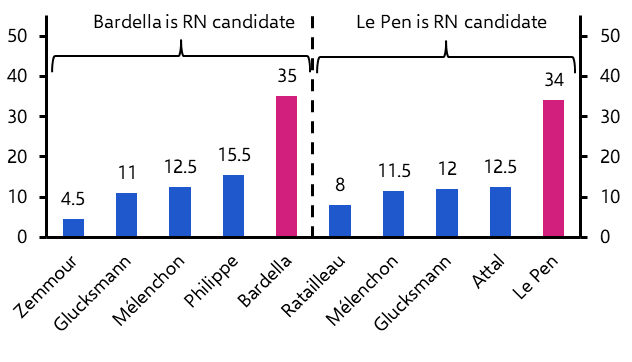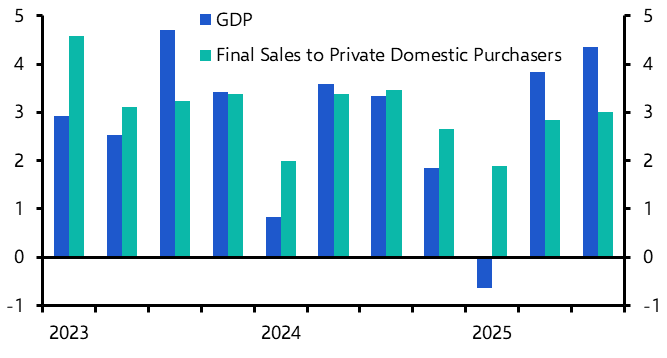The decision last week by the US government to impose additional tariffs on imports from China shouldn’t come as a surprise. As I argued a couple of months ago, the political dynamics on both sides of the trade war made it more likely that the conflict between Washington and Beijing would escalate rather than recede. Indeed, we had already factored the new tariffs announced by President Trump into our forecasts.
However, lingering in the background is a more fundamental concern – namely that we may be witnessing the end of globalisation. If so, the rapid increase in cross-border movement of goods, services, capital and people that has been the defining feature of the global economy over the past two decades may be about to reverse – with macroeconomic implications that would extend well beyond the narrow impact of tit-for-tat tariffs.
This is a theme that we will explore in more detail in forthcoming research and in a series of conferences across Europe this October. (For those interested in attending, you can register to attend here). A useful starting point is to look at the lessons from history.
There have been several periods of globalisation in the past. The German economic historian, Andre Gunder Frank, argued that the first instance of globalisation could be traced all the way back to the growth of trade between the Sumer and Indus civilisations in the third millennium BC. Trade routes between China and Europe developed during the Hellenistic Age (323 - 31 BC). And a drop in transport costs led to a period of global market integration in the sixteenth century.
More recently, though, it’s possible to identify three waves of globalisation in what we might call the modern era. The first came between 1870 and 1914, and was characterised by increased transatlantic trade as well as trade within Europe, and between Europe and its colonies. This period also saw a large rise in migration flows (particularly from Europe to the US).
The second wave of modern globalisation came between 1950 and 1971, and was characterised by a further increase in trade within Europe and between Europe and America.
Finally, there is the most recent wave of globalisation that began in the 1990s and has been defined by two things. The first is a sharp increase in trade across both developed and emerging markets. This is a break from previous waves of modern globalisation, which centred primarily on Europe and the Americas. The second feature has been a significant rise in cross-border capital flows.
Accordingly, the most recent period of globalisation has been broader than the previous waves of modern integration in two important ways. First, it has encompassed a greater number of countries and therefore touched the lives of many more people. And second it has had a more significant financial component – alongside the globalisation of production we have also experienced the globalisation of finance.
The fact that the periods of globalisation in the late 19th century and mid-20th century came to end means that it shouldn’t necessarily come as a great surprise if the current one also draws to a close. In fact, in many ways, this wave of globalisation may already have peaked. Measured as a share of global GDP, world trade flows have levelled off in recent years, while flows of foreign direct investment have fallen. (See Charts 1 & 2.) This may partly reflect a hangover from the global financial crisis. But even so it’s difficult to escape the conclusion that the recent period of globalisation is at, or nearing, an end.
Chart 1: Global Trade in Goods & Services (% of global GDP)

Chart 2: FDI Inflows (% of global GDP)

This raises two questions: are we now facing a roll-back of globalisation and, if so, should we be concerned? We’ll have more to say in forthcoming publications but a key part of the answer to the second question lies in what is driving this shift.
One possibility is that we are facing a relatively benign end to globalisation driven by technological change. New technologies, such as robotics and artificial intelligence, are likely to make it cheaper for firms to produce in one location rather than having to maintain comparatively expensive supply chains. Accordingly, whereas new technologies have previously facilitated globalisation, this time they might facilitate the re-shoring of economic activity. But given that this would just simply reflect firms seeking out more efficient ways of operating, this would surely be a good thing.
Of course, another possibility is that we could be facing a more malign form of de-globalisation driven by the deliberate erection of barriers by policymakers. The impact on the broader global economy may not be too bad if the current tensions remain limited to the US and China. What’s more, history shows that some countries may continue to integrate at the same time that others put up barriers. A protectionist shift by the US need not prevent economies in Europe and Asia from seeking closer ties.
However, there is a significant risk that the current trade war between the US and China represents the start of a wider backlash to globalisation that ultimately leads to the disintegration of the liberal rules-based system that has governed the cross-border flow of goods, capital and labour over the past 70 years. It’s even possible that this might lead to an eventual Balkanisation of the global economy, with US-, and China-led spheres of influence, each with separate payment systems, regulatory standards and technological platforms. It goes without saying that this would have much graver economic and market consequences.
These are the issues that we’ll cover in subsequent research and in our October conferences. For now it’s worth noting that perhaps the biggest lesson from history is that every wave of globalisation has been ended by a deliberate effort by policymakers to push back against integration. It’s too soon to say exactly how events will pan out, but this casts the escalation in the US-China trade war over the past year in an altogether more ominous light. We may be witnessing the end of the world as we know it.
In case you missed it:
(Requires Login)
- Our UK team takes stock of the weaker pound and assesses how much further it might fall in the event of a “no deal” Brexit.
- Our markets team has published its latest Global Markets Outlook, which contains forecasts and analysis of key asset markets over the next couple of years.
- We have published several pieces in response to the news that the White House will impose additional tariffs on China, assessing the potential impact on America, China and financial markets.



